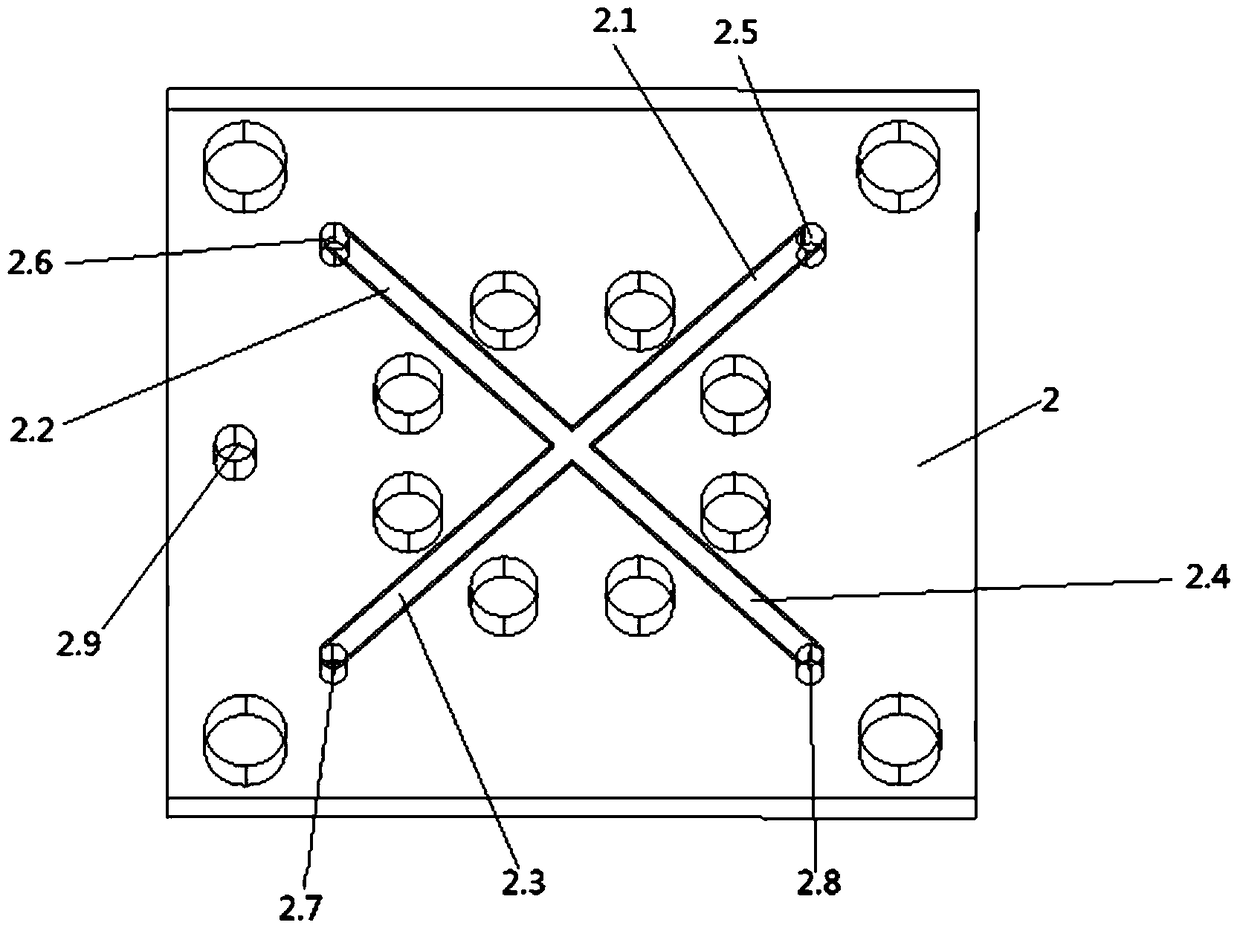Fully dispersed passive multi-stage focusing micro-mixer and its mixing method and application
A micro-mixer and passive technology, which is applied in the field of micro-chemical industry, can solve the problems of high processing precision and processing technology, complex processing of the mixer, and poor mixing effect, so as to improve the mixing effect, reduce the pressure drop, and promote the mixing. Effect
- Summary
- Abstract
- Description
- Claims
- Application Information
AI Technical Summary
Problems solved by technology
Method used
Image
Examples
Embodiment 1
[0046] Such as Figure 1 to Figure 7 The fully dispersed secondary focusing micromixer shown includes No. 1 to No. 5 plates. The corresponding No. 4 plate is an eight-channel system. The No. 1 plate is provided with a first feed hole 1.1 and a discharge hole 1.2; 2 There are channels 2.1 to 2.4 and circulation holes 2.5 to 2.8 on the No. 3 board; there are circulation holes 3.1 to 3.4, outlet circulation holes 3.5, and a discharge channel 3.6 on the No. 3 board; dispersing channels 4.1 to 4.8 are opened on the No. 4 board. Holes 4.9 to 4.12; channels 5.1 to 5.4 are opened on the adjacent side of No. 5 plate and No. 4 plate, and a second feed hole 5.5 is opened on the other side of No. 5 plate; No. 1 to No. 5 plates are closely attached to each other The channels 5.1 to 5.4 and the channels 4.5 to 4.8 are aligned with each other, the channels 2.1 to 2.4 are aligned with the channels 4.1 to 4.4, the circulation holes 2.5 to 2.8 are aligned with the circulation holes 3.1 to 3.4, a...
Embodiment 2
[0051] The difference from Example 1 is that the core component No. 4 board adopts a sixteen-channel three-stage focusing method, such as Picture 8 As shown, the number of dispersion channels in the No. 4 plate is sixteen channels, the width of the channel at the widest point is 1.8 mm, and the channel width at the narrowest point is 0.4 mm. The number of channels from the first mixing zone to the second mixing zone is changed from eight channels to four channels, and the channel width is 0.4mm. The depth of all channels adopted by the 4th board is 0.5mm, and the corresponding channels on the 2nd and 5th boards are all eight channels.
Embodiment 3
[0053] The difference from Example 1 is that the core component No. 4 board adopts a 32-channel four-level focusing method, such as Picture 9 As shown, the number of dispersing channels in the No. 4 plate is thirty-two channels, and the corresponding channel width at the widest point is 1.5 mm, and the channel width at the narrowest point is 0.3 mm. The number of channels from the first mixing zone to the third mixing zone changes from sixteen channels to eight channels to four channels, and the channel width is 0.3mm. The depth of all channels used by the No. 4 board is 0.3mm. The corresponding channels on board 2 and board 5 are all sixteen channels.
PUM
 Login to View More
Login to View More Abstract
Description
Claims
Application Information
 Login to View More
Login to View More - R&D
- Intellectual Property
- Life Sciences
- Materials
- Tech Scout
- Unparalleled Data Quality
- Higher Quality Content
- 60% Fewer Hallucinations
Browse by: Latest US Patents, China's latest patents, Technical Efficacy Thesaurus, Application Domain, Technology Topic, Popular Technical Reports.
© 2025 PatSnap. All rights reserved.Legal|Privacy policy|Modern Slavery Act Transparency Statement|Sitemap|About US| Contact US: help@patsnap.com



